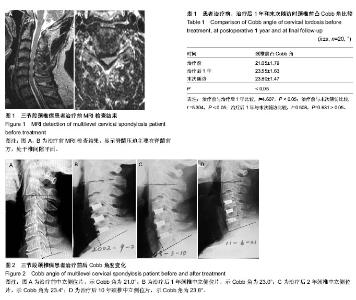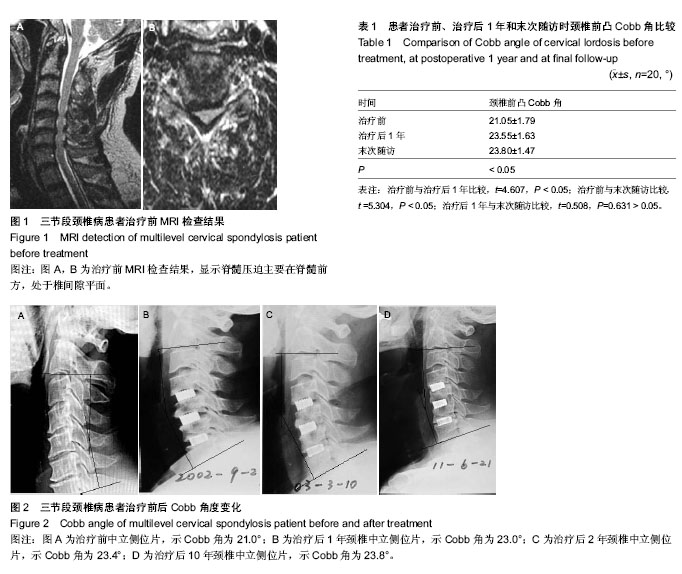| [1] Femyhough JC,White JI, LaRocca H. Fusion rates in multilevel cervicalspondylosis comparing allograft fibula with autograft fibula in 126 patients.Spine.1991;16(10 Suppl):561-564.
[2] Smith GW,Robinson RA.The treatment of certain cervical spine disorders by anterior removal of the intervertebral disc and interbody fusion.J Bone Joint Surg Am. 1958;40(3):607-624.
[3] 孙宇,刘忠军,党耕町.颈椎病外科治疗的回顾[J].北京大学学报(医学版),2002,34(5):627-629.
[4] Odom GL,Finney W,Woodhall B.Cervical disk lesions.J Am Med Assoc. 1958;166:23-28.
[5] Barsa P,Suchomel P.Factors affecting sagittal malaligament due to Cage subsidence in standalone cage assisted anterior cervical fusion. Eur Spine J. 2007;16(7):1395-1400.
[6] 贾连顺.颈椎病的手术时机与手术方案选择[J].中国脊柱脊髓杂志,2007,17(2):90.
[7] Wang JC,McDonough PW,Kanim LE,et al.Increased fusion rates with cervical palting for fhree-level anterior cervical discectomy and fusion.Spine. 2001;26:643-647.
[8] Hilibrand AS,Fye MA,Emery SE,et al.Increased rate of arthrodesis with strut Grafting after multilevel anterior cervical decompression.Spine. 2002;27:146-151.
[9] Nirala AP,Husain M,Vatsal DK.A retrospective study of multiple interbody grafting and long segment strut grafting following multilevel anterior cervical Decompression.Br J Neurosurg. 2004;18:227-232.
[10] 鲍达,马远征,袁文,等.前路融合内固定方式对颈椎曲度的影响[J].中华骨科杂志,2004,24(12):705-708.
[11] Hilibrand AS,Carlson GD,Palumbo MA,et al.Radiculopathy and myelopathy at segments adjacent to the site of a previous anterior cervical Arthrodesis.J Bone Joint Surg Am. 1999;81 (4):519-528.
[12] Goto S,Kita T.Long-term follow-up evaluation of surgery for ossification of the posterior longitudinal ligament.Spine. 1995; 20(20):2247-2256.
[13] Katsuura A,Hukuda S,Sarahashi Y,et al.Kyphotic malalignment after anterior cervical fusion is one of the factors promoting the degenerative process in adjacent intervertebral levels.Eur Spine J.2001;10:320-324.
[14] Matge G.Cervical cage fusion with 5 different implants:250 cases. Acta Neurochir(Wien). 2002;144(6):539-550.
[15] Montgomery DM,Brower RS.Cervical spondylotic myelopathy.Clinical syndrome And natural history.Orthop Clin North Am. 1992;23(3):487-493.
[16] 贾连顺,史建刚.重视脊髓型颈椎病的诊断与严格手术指征[J].中华骨科杂志,2002,22(1):58-60.
[17] 孙宇.颈椎病手术治疗中值得关注的几个问题[J].中国脊柱脊髓杂志,2007,17(2):95-96.
[18] Barsa P, Suchomel P. Factors affecting sagittal malalignment due to cage subsidence in standalone cage assisted anterior cervical fusion. Eur Spine J. 2007;16(9):1395-1400.
[19] Vamvanij V, Ruangchainikom M, Thanapipatsiri S, et al. The outcomes of combined posterior instrumentation and anterior radical debridement with fusion for multilevel spinal tuberculosis. J Med Assoc Thai. 2014;97 Suppl 9:S50-55.
[20] Moon MS, Kim SS, Yoon MG, et al. Radiographic Assessment of Effect of Congenital Monosegment Synostosis of Lower Cervical Spine between C2-C6 on Adjacent Mobile Segments. Asian Spine J. 2014;8(5):615-623.
[21] Ament JD,Yang Z, Nunley P, et al. Cost-effectiveness of Cervical Total Disc Replacement vs Fusion for the Treatment of 2-Level Symptomatic Degenerative Disc Disease. JAMA Surg. 2014. doi: 10.1001/jamasurg.2014.716.
[22] Caruso R, Pesce A, Marrocco L, et al. Anterior approach to the cervical spine for treatment of spondylosis or disc herniation: Long-term results. Comparison between ACD, ACDF, TDR. Clin Ter. 2014;165(4):e263-270.
[23] Kao TH, Wu CH, Chou YC, et al. Risk factors for subsidence in anterior cervical fusion with stand-alone polyetheretherketone (PEEK) cages: a review of 82 cases and 182 levels. Arch Orthop Trauma Surg. 2014;134(10): 1343-1351.
[24] Gologorsky Y, Skovrlj B, Steinberger J, et al. Increased incidence of pseudarthrosis after unilateral instrumented transforaminal lumbar interbody fusion in patients with lumbar spondylosis. J Neurosurg Spine. 2014;21(4):601-607.
[25] Rampersaud YR, Fisher C, Yee A, et al. Health-related quality of life following decompression compared to decompression and fusion for degenerative lumbar spondylolisthesis: a Canadian multicentre study. Can J Surg. 2014;57(4): E126-133.
[26] Huang ZY, Wu AM, Li QL, et al. Comparison of two anterior fusion methods in two-level cervical spondylosis myelopathy: a meta-analysis. BMJ Open. 2014;4(7):e004581.
[27] Schairer WW, Carrer A, Lu M, et al. The Increased Prevalence of Cervical Spondylosis in Patients with Adult Thoracolumbar Spinal Deformity. J Spinal Disord Tech. 2014. [Epub ahead of print] |

